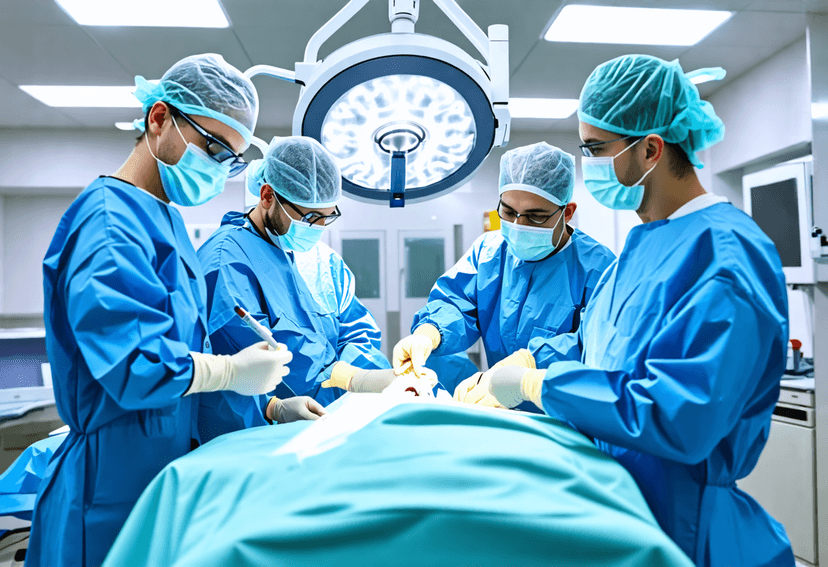
Robotic-Assisted Liver Transplantation at King's College Hospital Dubai
18 Jul, 2024
 Healthtrip Team
Healthtrip TeamAt King's College Hospital Dubai, we're excited to share with you how robotic-assisted surgery is transforming liver transplantation. It's not just about cutting-edge technology; it's about revolutionizing patient care and outcomes. Let's dive into how this innovative approach is making a difference in the field of liver transplantation. Robotic-assisted surgery involves the use of robotic systems to assist surgeons during complex procedures like liver transplantation. At King's College Hospital Dubai, this technology integrates high-definition cameras and robotic arms controlled by experienced surgeons. These advancements enable:
Most popular procedures in India
Robotic-Assisted Liver Transplantation: A Detailed Procedure
Liver transplantation is a complex surgical procedure aimed at replacing a diseased or failing liver with a healthy liver from a deceased or living donor. Robotic-assisted surgery has revolutionized this field by offering enhanced precision, minimal invasiveness, and improved outcomes for patients undergoing this life-saving procedure. Let's delve into the detailed steps involved in robotic-assisted liver transplantation:
Wellness Treatments
Give yourself the time to relax
Lowest Prices Guaranteed!

Lowest Prices Guaranteed!
A. Pre-operative Phase
1. Patient Evaluation and Preparation:
a. Medical Assessment: Patients undergo a comprehensive medical evaluation to assess liver function, overall health, and eligibility for transplantation. This includes blood tests, imaging studies (such as CT scans or MRI), and consultations with hepatologists and transplant surgeons.
b. Psychosocial Evaluation: Evaluation includes assessing the patient's readiness for surgery, understanding the psychological aspects, and ensuring adequate support systems for post-operative care and recovery.
c. Educational Counseling: Patients and their families receive detailed information about the transplantation process, including risks, benefits, and post-operative care requirements.
2. Surgical Planning:
a. Multidisciplinary Team Approach: A team of specialists, including transplant surgeons, hepatologists, anesthesiologists, radiologists, and nurses, collaborates to plan the surgery.
b. Imaging and Mapping: Advanced imaging techniques, such as CT angiography or MRI, are used to map the patient's liver anatomy, blood vessels, and bile ducts. This helps in planning the surgical approach and ensuring the compatibility of the donor's liver.
B. Surgical Procedure
1. Anesthesia and Incision:
a. Anesthesia Administration: The surgery begins with the administration of general anaesthesia to ensure the patient remains unconscious and pain-free throughout the procedure.
b. Incision: The surgeon makes several small incisions (usually 1-2 cm in length) in the abdomen. These incisions serve as ports for inserting the robotic arms and camera system.
2. Robotic System Setup:
a. Placement of Trocars: Trocars are inserted through the incisions to create passages for the robotic arms and camera.
b. Robotic Console Setup: The surgeon then moves to the console, where they control the robotic arms equipped with surgical instruments. The console provides a high-definition, three-dimensional view of the surgical field.
3. Surgical Access and Exploration:
a. Camera Insertion: A high-definition camera is inserted through one of the trocars to provide a magnified view of the abdominal cavity.
b. Robotic Arm Insertion: The robotic arms, which hold specialized surgical instruments, are inserted through the remaining trocars. These instruments mimic the movements of the surgeon's hands with enhanced dexterity and precision.
4. Liver Dissection and Preparation:
a. Diseased Liver Removal: The diseased liver is carefully dissected and disconnected from its blood vessels (hepatic artery, portal vein) and bile ducts. Robotic assistance allows for meticulous dissection, reducing the risk of bleeding and damage to surrounding tissues.
b. Donor Liver Preparation: Simultaneously, the donor liver (either from a deceased or living donor) is prepared in the adjacent operating room. It is preserved in a specialized solution and transported to maintain its viability.
5. Implantation of Donor Liver:
a. Vascular Anastomosis: The donor's liver is carefully positioned and connected to the recipient's blood vessels (hepatic artery and portal vein) using sutures or vascular clips. Robotic-assisted suturing ensures precise and secure connections, crucial for maintaining blood flow to the transplanted liver.
b. Biliary Reconstruction: The bile ducts of the donor's liver are then connected to the recipient's bile ducts using fine sutures. This step is critical to ensure proper drainage of bile from the liver.
6. Closure and Completion:
a. Monitoring and Verification: Throughout the procedure, the surgical team monitors blood flow and liver function to ensure the successful transplantation of the donor's liver.
b. Closure of Incisions: After confirming the functionality of the transplanted liver, the robotic instruments are withdrawn, and the small incisions are closed with sutures or surgical staples.
C. Post-operative Care
1. Recovery and Monitoring:
a. Immediate Post-operative Care: The patient is transferred to the recovery room, where vital signs are closely monitored as they wake up from anaesthesia.b. Intensive Care: Depending on the patient's condition, they may initially be monitored in the intensive care unit (ICU) to ensure stability and manage post-operative complications.
2. Hospital Stay and Rehabilitation:
a. Specialized Care: Patients receive specialized care from a multidisciplinary team, including transplant surgeons, hepatologists, nurses, and physiotherapists.b. Medication Management: Immunosuppressive medications are prescribed to prevent rejection of the transplanted liver and are carefully monitored and adjusted based on blood tests and clinical evaluations.
3. Long-term Follow-up:
a. Outpatient Visits: Patients are scheduled for regular follow-up visits to monitor liver function, assess medication efficacy, and address any complications or concerns.
b. Lifestyle Management: Patients are advised on lifestyle modifications, including diet, exercise, and avoiding alcohol and certain medications that may affect liver function.
Benefits of Robotic-Assisted Liver Transplantation
Enhanced Precision: The robotic system provides a magnified, high-resolution 3D view of the surgical site, allowing surgeons to perform intricate manoeuvres with unmatched precision.
Minimally Invasive Approach: Unlike traditional open surgeries, robotic-assisted techniques require smaller incisions, reducing trauma to surrounding tissues, minimizing blood loss, and lowering the risk of infection.
Quicker Recovery: Patients undergoing robotic-assisted liver transplantation often experience shorter hospital stays and faster recovery times compared to conventional surgery, contributing to improved postoperative outcomes.
Robotic-assisted liver transplantation represents a significant advancement in surgical techniques, offering patients with end-stage liver disease a new lease on life. At King's College Hospital Dubai, we are committed to leveraging cutting-edge technology and expert care to achieve optimal outcomes for our patients. This innovative approach continues to evolve, pushing the boundaries of what's possible in liver transplantation and ensuring that more patients can benefit from this life-saving treatment.
Advancements in Robotic Technology at King's College Hospital Dubai
Robotic-assisted liver transplantation at King's College Hospital Dubai utilizes cutting-edge robotic systems to enhance surgical precision and patient outcomes. These systems integrate sophisticated robotic platforms with state-of-the-art imaging, real-time feedback mechanisms, and ergonomic advantages for surgeons.
1. Robotic Systems: The hospital employs the da Vinci Surgical System, renowned for its precision and versatility in minimally invasive surgeries. Equipped with robotic arms and a high-definition camera, it provides surgeons with a magnified, three-dimensional view of the surgical site.
2. Enhanced Imaging: The da Vinci system offers high-definition visualization, surpassing human eye capabilities. This clarity aids in precise manipulation of vital structures such as blood vessels and bile ducts during liver transplantation.
3. Real-time Feedback: Incorporating haptic feedback, surgeons receive tactile sensations that enhance control and minimize tissue damage. This feedback loop ensures precise movements during surgery.
4. Ergonomic Design: Surgeons operate from a console, seated comfortably with ergonomic controls translating their hand movements into precise robotic actions. This setup reduces fatigue and enhances surgical dexterity.
5. Integrated Technologies: Advanced imaging modalities like CT angiography aid in real-time navigation and verification of surgical outcomes, complementing robotic systems for optimal precision and patient safety.
6. Innovation and Training: The hospital prioritizes continuous innovation and surgeon training in robotic surgery techniques, ensuring proficiency and adherence to best practices. Research initiatives further advance robotic technologies in liver transplantation.
Technological advancements in robotic-assisted surgery at King's College Hospital Dubai have redefined liver transplantation, offering safer and more precise treatment options with improved recovery outcomes. By leveraging cutting-edge robotic platforms and integrated technologies, the hospital remains committed to enhancing patient care and advancing the field of robotic-assisted liver transplantation.
How can HealthTrip assist with your treatment?
If you're seeking Liver Transplantation, let HealthTrip be your compass. We support you throughout your medical journey with the following:
- Access to top doctors in 38+ countries and the largest health travel platform.
- Partnerships with 1500+ hospitals, including Fortis, Medanta, and more.
- Treatments in neuro, cardiac care, transplants, aesthetics, and wellness.
- Post-treatment care and assistance.
- Teleconsultations with leading doctors at $1/minute.
- Over 61K patients served.
- Access Top treatments and packages, such as Angiograms and many more.
- Gain insights from genuine patient experiences and testimonials.
- Stay updated with our medical blog.
- 24/7 unwavering support, from hospital formalities to travel arrangements or emergencies.
Hear from our satisfied patients
In conclusion, the integration of robotic-assisted surgery at King's College Hospital Dubai exemplifies how technology can enhance surgical precision and patient care, setting a new benchmark for excellence in liver transplantation.
Related Blogs

Elevate Your Health and Wellness with Enhance by Mediclinic
Discover how our team of experts can help you achieve

Revolutionizing Healthcare in Dubai with Mediclinic Meaisem
Discover the latest medical advancements and cutting-edge technology at Mediclinic

Transforming Healthcare, One Patient at a Time at The Clementine Churchill Hospital
The Clementine Churchill Hospital, part of Circle Health Group, offers

Transforming Healthcare, One Patient at a Time at The Clementine Churchill Hospital
The Clementine Churchill Hospital, part of Circle Health Group, offers

Revolutionizing Neurosurgery in Istanbul: NPISTANBUL Brain Hospital
NPISTANBUL Brain Hospital is leading the way in neurosurgery with

Healthcare Redefined at King's College Hospital
King's College Hospital London offers cutting-edge medical treatments and exceptional











